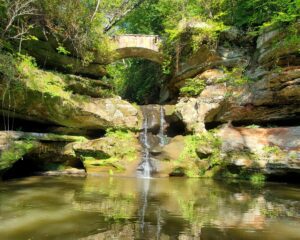The Hocking Hills Visitor Center, located at 13178 State Route 664 South, Logan, Ohio 43138, is open Monday through Saturday from 9 a.m. to 5 p.m., and Sunday from 11 a.m. to 5 p.m.
)
From Columbus, take US-33 East for approximately an hour, enjoying scenic views along the way. Exit onto OH-374 South, and follow the winding roads that lead you to one of Ohio’s most breathtaking natural escapes.
Hocking Hills State Park offers designated RV and motorcycle parking areas, ensuring convenience for all visitors. Accessible parking and bike racks for cyclists enhance accessibility and promote outdoor activities.
Accessibility & permits
Emergency
- Cell service availability:Full
Information not accurate?
Help us improve by making a suggestion.
Hocking Hills State Park in Ohio stands as a testament to nature’s artistry, offering visitors a breathtaking retreat into the heart of the Appalachian foothills. With its dramatic cliffs, cascading waterfalls, and lush forests, the park invites adventurers to explore its myriad trails, each revealing a new facet of its stunning landscape. The iconic Old Man’s Cave, with its striking rock formations and serene pools, serves as a focal point for hikers and photographers alike.
As you traverse the winding paths, the park’s diverse ecosystems unfold, showcasing vibrant flora and fauna. The sound of rushing water accompanies your journey, particularly at Cedar Falls, where the beauty of the cascading water captivates the senses. Each season transforms the park, from the vibrant autumn foliage to the tranquil snowscapes of winter, ensuring that every visit offers a unique experience.
Hocking Hills State Park also caters to those seeking a luxurious escape. Nearby, charming cabins and upscale lodges provide the perfect base for relaxation after a day of exploration. Indulge in gourmet dining options that celebrate local flavors, making your stay not just an adventure but a culinary delight.
Top 3 Facts about Hocking Hills State Park
In this region, the annual migration of the rare cerulean warbler attracts birdwatchers, while unusual sightings of the elusive eastern hellbender, North America’s largest salamander, highlight the area’s unique biodiversity, showcasing a rich tapestry of endemic species thriving in its diverse habitats.
Hocking Hills experiences unique microclimates due to its varied topography, leading to distinct weather patterns; for instance, temperature differences can be extreme between the valley floor and the ridges, resulting in diverse ecosystems and unusual frost formations that can persist even in warmer months.
Known for its stunning landscapes, this destination features the world’s longest zip line in a state park and bizarre trail names like “Old Man’s Cave”; unusual rules prohibit swimming in certain areas and ban alcohol, ensuring a serene experience amidst nature’s beauty.
Family programs
- Junior Ranger
- Ranger-led Tours
- Self-guided Tours
- Workshops & Hands-on Activities
- Living History & Cultural Demos
- Scavenger Hunts
- Night Sky & Astronomy
- Family Camping & Overnight
- Volunteer & Stewardship
- Youth Conservation
- Scouting Partnerships
- Virtual Junior Activities
- Arts & Crafts
- Water-based Adventures
Travel Tips
Plan Ahead
When visiting this stunning natural wonder, planning ahead is essential for an unforgettable experience. Research trail conditions, weather forecasts, and popular attractions to maximize your adventure. Arrive early to avoid crowds and secure parking, and consider packing a picnic to enjoy amidst the breathtaking scenery. Don’t forget to download maps or trail guides to navigate the area with ease.
Pack Appropriately
When packing for your adventure, include a pair of sturdy water shoes; the park’s stunning waterfalls and creeks invite exploration, and navigating the rocky terrain can be tricky. Also, consider a lightweight backpack to carry essentials like snacks and a water bottle, ensuring you stay energized while you trek through the lush, hilly landscapes.
Respect Wildlife
Respect local wildlife by observing animals from a distance and avoiding feeding them. This helps maintain their natural behaviors and keeps both visitors and animals safe. Stay on designated trails to protect habitats and ensure that your presence does not disrupt the delicate ecosystem. Remember, your actions can significantly impact the natural beauty and biodiversity of this stunning area.
Stay Informed
Before visiting, stay informed by checking the weather, current temperatures, and any fire bans or notices in the area. Always inform someone of your destination and expected return time, and ensure you have emergency contact information handy. Being prepared helps ensure a safe and enjoyable experience.
Seasons
In spring, the park’s trails are adorned with vibrant wildflowers, and its waterfalls are at their most impressive, offering a serene and picturesque hiking experience.
Summer in Hocking Hills offers warm temperatures and lush greenery, perfect for hiking, camping, and festivals like the Nelsonville Music Festival and LilyFest.
In autumn, the region’s vibrant foliage and crisp air create an ideal setting for hiking, scenic drives, and seasonal festivals, making September through November the perfect time to visit.
Experience the serene beauty of frozen waterfalls, snow-draped cliffs, and peaceful trails during the winter months, offering a tranquil retreat from the usual crowds.
Information not accurate?
Help us improve by making a suggestion.
Where to stay
Frequently Asked Questions
Ready to dive into what Hocking Hills State Park has to offer? Let’s tackle some of the burning questions you might have as you plan your visit!
-
Yes, there is no admission fee at Hocking Hills State Park, making it an affordable destination for outdoor enthusiasts.
-
Pets are allowed on hiking trails at Hocking Hills State Park, but they must be kept on a leash and cleaned up after. Some areas may have specific restrictions, so it’s best to check local guidelines.
-
The best times to visit Hocking Hills State Park to avoid crowds are typically early morning on weekdays or during the off-season in late fall and winter. Visiting during weekdays in spring and fall can also help you enjoy the park with fewer people.
-
Yes, there are wheelchair accessible trails in Hocking Hills State Park, including the Ash Cave and the Cedar Falls trails, which offer beautiful views and easy access for those with mobility challenges.
-
Besides hiking, Hocking Hills State Park offers a variety of outdoor activities including zip-lining, fishing, canoeing, rock climbing, and bird watching, providing a diverse experience for all visitors.






